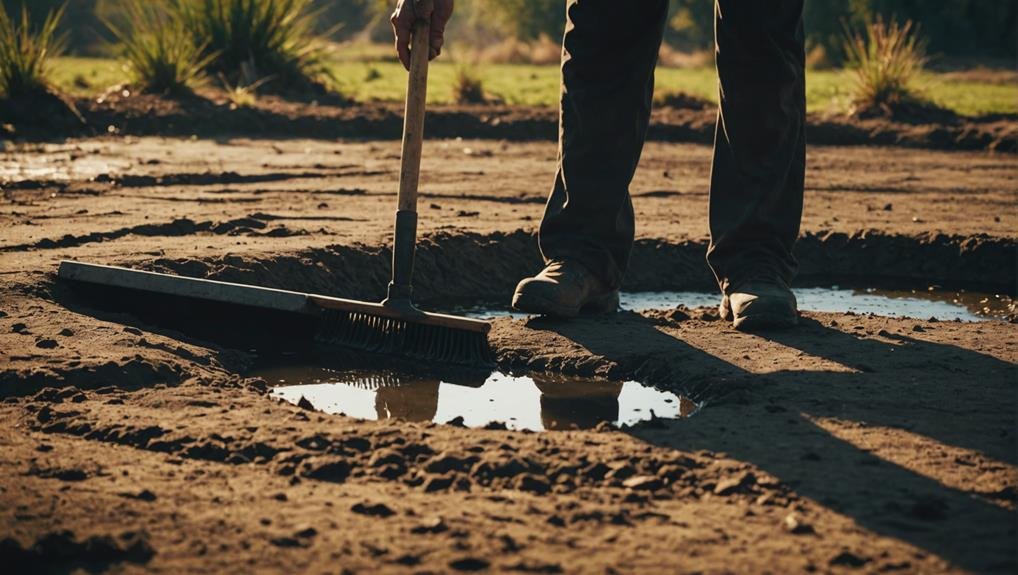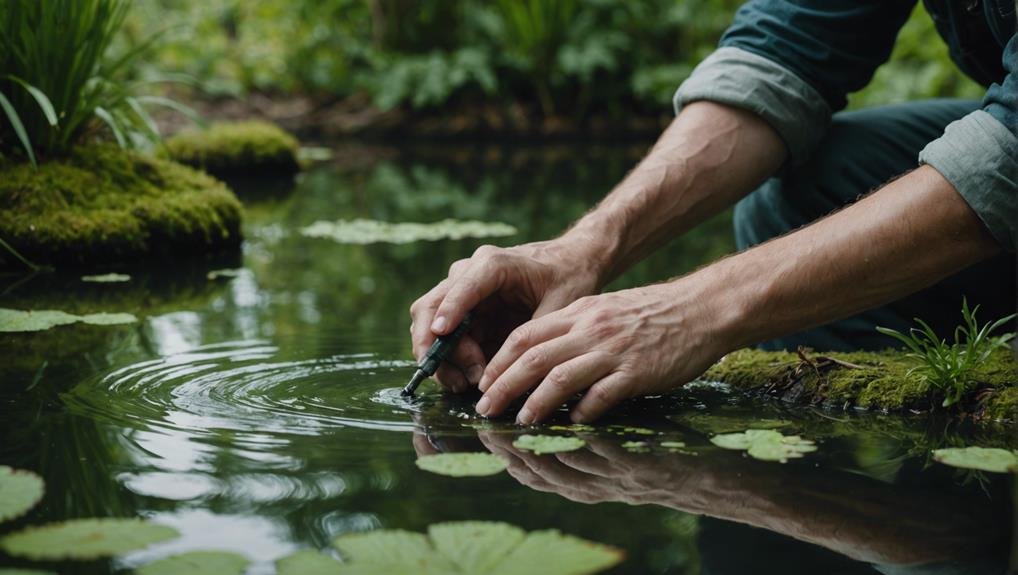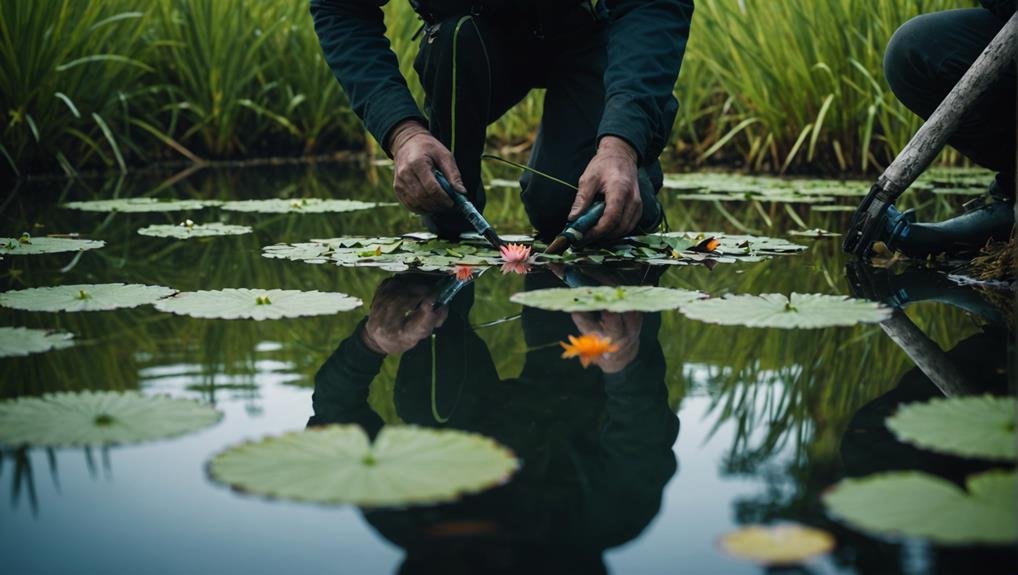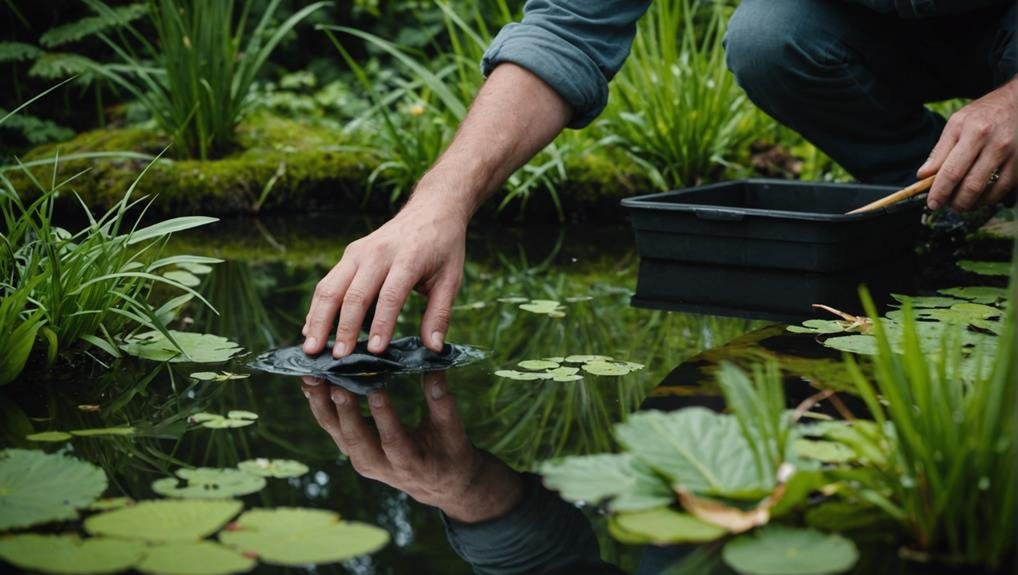When fixing leaks in pond liners, the first step is to locate the leak by monitoring the water level and turning off the pump for 24-48 hours. Once the leak is identified, clear debris, clean, and dry the area thoroughly. To make repairs, underwater sealants or patches can be used.
WaterWeld is a highly effective option for strong, non-toxic sealing. For larger leaks, products like Pond Pro 2000 offer durable solutions. Regular maintenance, such as inspecting for damage and removing debris, is essential to prevent future leaks.
Investing in high-quality, UV-resistant liners can also help extend the lifespan and reliability of the pond liner. For more detailed steps and tips on fixing leaks in pond liners, let's delve deeper into the process.
Identifying the Leak
To effectively identify leaks in pond liners, start by monitoring the water level. Turn off the water pump and observe the water level for 24-48 hours to pinpoint the leak. If the water level stabilizes below a certain point, it indicates the potential location of the leak. Look for signs of water loss to determine if the issue is in the main basin or plumbing connections.
In some cases, draining the pond to let the water level settle can help locate the exact source of the leak more accurately. After draining the pond, clean and dry the area around the water level to inspect for tears, holes, or other damage in the pond liner.
Consider moving fish to a temporary holding environment during this process to ensure a clean and dry inspection area, increasing the chances of finding the leak accurately. Identifying the source of a leaking pond is crucial for initiating the repair process.
Clearing the Area
Preparing the area around the leak is crucial for ensuring a successful pond liner repair. To begin the repair process, the first step is to clear away any rocks, debris, or plants near the damaged section. This step is essential as it allows easy access to the liner, making the repair of leaks more efficient.
By clearing the area surrounding the leak, we eliminate any obstructions that could hinder the repair process. This is important because a clean surface promotes proper adhesion of the repair materials. Ensuring a strong bond between the liner and the patch is key to a lasting fix, preventing potential future issues.
After clearing the area, it's important to thoroughly dry the surface to prevent any moisture from being trapped under the repair patch. Moisture trapped beneath the patch can compromise the effectiveness of the repair, leading to further damage over time.
Taking the time to clear and dry the area before proceeding with the repair enhances the longevity of the fix and helps maintain the integrity of the water feature.
Cleaning and Drying

To ensure a successful repair, it's crucial to have a spotless and dry pond liner. Start by thoroughly cleaning the area around the leak to remove any debris, algae, or dirt that could affect the repair materials' adhesion.
Gently scrub the liner with a soft brush or cloth to get rid of any unwanted particles. For stubborn algae, a mild detergent can be used, but make sure to rinse it off completely to avoid leaving any residue.
After cleaning, it's essential to dry the damaged section completely. Any leftover moisture on the liner can impact the effectiveness of the sealant or patch. Use a clean towel to wipe down the area and allow it to air dry thoroughly.
If needed, a hair dryer on a low setting can help speed up the drying process, but be cautious not to overheat the liner material.
Applying Repair Products
When fixing your pond liner, it's crucial to apply the right repair products for a lasting solution. For small holes, an underwater sealant is ideal as it sticks even when the liner is wet, ensuring a quick and effective fix. In the case of larger holes, it's best to use a patch along with the sealant for a strong repair. Repair kits are handy for this job as they contain all the necessary items like primer, a patch, and sealant. Following the instructions provided in the repair kit is key to a successful outcome.
To identify leaks in your pond, you can use the Milk Method by squirting a bit of milk near the suspected area and observing where it gets absorbed. Once the leak is pinpointed, you can proceed to use pond repair kits to mend it.
After applying the sealant or patch, allow the repair to dry for 24 hours before refilling the pond. This waiting period ensures that the repair sets properly and effectively seals the leaks, preventing further issues down the line.
Using WaterWeld

WaterWeld is an excellent solution for quickly and effectively fixing leaks in pond liners. This two-toned putty is specially made to seal leaks in various materials, providing strong adhesion. Its versatility allows for use in both above and below waterline repairs, making it suitable for different pond settings.
To use WaterWeld, simply knead the putty to activate it, ensuring instant bonding and eliminating the need for drying time. This immediate action is especially beneficial when prompt leak repairs are necessary to prevent water loss.
One of WaterWeld's key benefits is its non-toxic composition, ensuring the safety of pond life during repairs. Its durability also guarantees a long-lasting fix, reducing the chances of future issues.
Alternative Repair Solutions
Pond owners have a variety of effective options for fixing liner leaks, such as Pond Pro 2000 and WaterWeld. Pond Pro 2000 is a popular choice due to its UV resistance, non-toxic nature, and long-lasting durability, making it safe for fish and providing a reliable repair solution. On the other hand, WaterWeld, a two-toned putty, is excellent for sealing leaks in pond liners, even in freezing temperatures.
UV resistance is a key feature of both Pond Pro 2000 and WaterWeld, allowing them to withstand prolonged exposure to sunlight without deteriorating. Additionally, these products are non-toxic, ensuring the safety of fish and other aquatic life in the pond. Their durability and puncture resistance make them reliable for long-term repairs in the challenging pond environment. Moreover, their ability to function effectively in colder temperatures makes them suitable for year-round use.
Regular Maintenance

Regular maintenance is crucial for maintaining the integrity of our pond liner and preventing leaks. It's important to regularly inspect the liner for any signs of wear, tears, or damage to address issues promptly and avoid larger problems in the future.
Clearing debris and vegetation is also essential to prevent punctures and tears that can result from neglect.
Consistently monitoring the water levels in the pond is key to detecting any sudden drops, which could indicate a leak. Any significant changes in water levels should prompt immediate attention to prevent further damage. Establishing a maintenance schedule ensures that these tasks are consistently addressed to keep the pond liner in optimal condition.
Using a pond liner underlay can provide an additional layer of protection, extending the lifespan of the liner by safeguarding it against sharp objects and rough surfaces. Incorporating this practice into our regular maintenance routine can minimize the risk of leaks and preserve the beauty and health of our pond.
While maintenance may seem like a chore, the long-term benefits for the pond's longevity make it a worthwhile investment.
Preventive Measures
To keep our pond liner free from leaks, it's important to take preventive measures alongside regular maintenance. Using a pond underlay before installing the liner is crucial as it acts as a protective barrier against sharp objects that could puncture it.
Make sure to clear any sharp debris or rocks from the pond area to prevent damage over time.
Consistently monitoring water levels is essential. A sudden drop could indicate a leak that needs immediate attention, so keeping an eye on the water level allows for early detection and timely repairs.
Additionally, using joining tape to seal seams or any repairs is vital for preventing leaks in those areas.
Here are some key preventive measures to follow: using pond underlay, removing sharp debris and rocks, monitoring water levels, and using joining tape for repairs.
Selecting Durable Liners

Choosing the right pond liner is crucial for the longevity and reliability of our water feature. Opting for a high-quality liner with UV warranties can extend its lifespan up to 20 years by protecting it from the damaging effects of UV rays.
While PVC liners may be more affordable, their thinness makes them susceptible to leaks. Investing in more durable materials can help us avoid frequent repairs and maintenance.
When installing the liner, it's essential to ensure that it's clean and free of any debris to prevent initial damage. Using a pond underlay adds an extra layer of protection against root damage and sharp objects.
Properly sealing joints between liners is also important to prevent future leaks from occurring.
In the event of a leak, using EPDM repair kits can provide a reliable solution, especially for larger damages. These kits are designed to withstand various weather conditions and ensure a long-lasting fix.
Regular inspections and immediate repairs are essential to maintaining the pond liner in good condition and maximizing its lifespan. By following these steps, we can enjoy a beautiful and functional water feature for years to come.
Conclusion
We've discussed the essential steps to repair leaks in pond liners, starting with pinpointing the issue and choosing quality materials for the fix. Surprisingly, a study revealed that 30% of pond leaks stem from poorly installed liners.
By following our guidance, we can significantly prolong the lifespan of our ponds. Consistent upkeep and preemptive actions play a crucial role in preventing future leaks.
Let's ensure that our ponds stay free from leaks, providing us with years of enjoyment.

